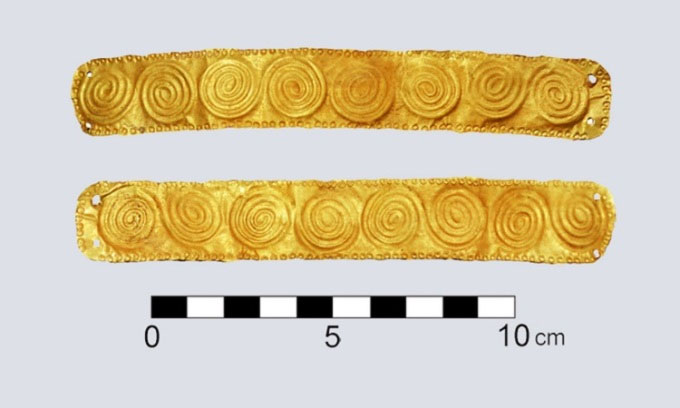A research team has discovered numerous gold, silver, and bronze artifacts, along with rose quartz, lapis lazuli, and amber in the tomb of a noble family from the Bronze Age.
Archaeologists from the University of Gothenburg conducted excavations at two tombs in the Hala Sultan Tekke area, a Bronze Age site in Cyprus. They uncovered over 150 skeletons and nearly 500 artifacts, including gold jewelry, gemstones, and ceramics dating back to around 1350 BC.

Gold crown buried with a child’s skeleton. (Photo: Teresa Bürge)
Since 2010, the Söderberg expedition has conducted several excavation campaigns in Cyprus. In 2018, the archaeological team found two underground chamber tombs along with a large number of skeletons. The careful handling of these discoveries took over four years due to the fragility of the bones after more than 3,000 years buried in saline soil. The remains and burial items were stacked in multiple layers, indicating that the tomb was used over many generations.
Analysis revealed that this was a family tomb of the ruling elite of the city. For instance, the research team found the skeleton of a 5-year-old child accompanied by a necklace, earrings, and a gold crown. This child may have belonged to a very powerful and wealthy family, according to Professor Peter Fischer, the head of the excavation team.
The findings include jewelry and numerous other objects made from gold, silver, bronze, ivory, and gemstones, along with intricately decorated vases from various cultures. The excavators also uncovered a ceramic bull. The hollow body of the bull features two openings: one on the back for pouring liquids like wine and another at the nose for drinking.
One particularly significant discovery is a cylindrical seal made from hematite with cuneiform inscriptions from the Mesopotamian civilization (modern-day Iraq). Additionally, the research team found red carnelian gemstones from India, blue lapis lazuli from Afghanistan, and amber from the Baltic Sea. This evidence highlights the city’s vital role in trade during the Bronze Age. The gold jewelry was accompanied by a scarab amulet and fish remains imported from the Nile Valley.
By comparing these findings with similar discoveries from Egypt, Fischer and his colleagues were able to date the jewelry. The results indicate that most of the artifacts were created during the reign of Queen Nefertiti and her husband Akhenaten around 1350 BC, including a gold lotus-shaped pendant set with gemstones. Queen Nefertiti is also known to have worn similar jewelry. The next step in the research is to analyze the DNA of the skeletons.


















































